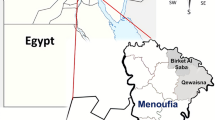Summary
The serological prevalence of bovine babesiosis and anaplasmosis in the traditional farming sector of six provinces of Zambia was determined using the indirect fluorescent antibody test (IFAT) for babesiosis and the card agglutination test (CAT) for anaplasmosis. Antibodies toBabesia bigemina occurred throughout the country whereas the prevalence ofB. bovis followed the distribution of its tick vectorBoophilus microplus which is limited to the north-eastern part of the country. Low numbers ofB. bovis serologically positive cattle were demonstrated in central and southern Province.Anaplasma spp. occurred throughout Zambia but the overall percentages of positive sera were low ranging between 14.7% and 38.6% using the CAT. Two hundred sera were retested for anaplasmosis using an enzyme-linked immunosorbent assay (ELISA). Sero-prevalence rates were 1.5 to 2.3-fold greater with the ELISA than with the card agglutination test.
Résumé
On a déterminé la prévalence sérologique de la babésiose et de l'anaplasmose bovine dans le secteur traditionnel d'élevage de six provinces de Zambie en mettant en oeuvre le test de fluorescence indirecte (IFAT) pour la babésiose et test d'agglutination sur carte (CAT) pour l'anaplasmose. Des anticorps contreBabesia bigemina sont rencontrés dans tout le pays alors que la prévalence deB. bovis suit la distribution de sa tique vectriceBoophilus microplus qui est limitée à la partie nord-est. Dans les provinces de centre et du sud, on n'a rencontré qu'un petit nombre de bovins ayant une sérologie positive pourB. bovis.
DesAnaplasma spp. se rencontrent dans toute la Zambie mais le pourcentage général est bas, se situant entre 14,7 et 38,6% avec le CAT. Deux cents sérums ont été retestés pour l'anaplasmose par une méthode immunoenzymatique (ELISA). Les taux de séro-prévalence ont été de 1,5 à 2,3 fois plus grands avec l'ELISA qu'avec le CAT.
Resumen
Se determinó la prevalencia serológica de la babesiosis y anaplasmosis bovina, en el sector ganadero tradicional de seis provincias de Zambia, mediante la utilización de la prueba indirecta de anticuerpos fluorescentes (IFAT) para babesiosis y la prueba de aglutinación en tarjeta (CAT) para anaplasmosis. Se detectaron anticuerpos deBabesia bigemina a través de todas las provincias, mientras que la distribución deB. bovis siguió la distribución del vectorBoophilus microplus, la cual se limita a la parte nordeste del país. Se detectaron números bajo de ganado serológicamente positivo aB. bovis en las provincias centrales y del sur. La anaplasmosis se detectó a través de Zambia, pero el porcentaje de sueros positivos fue bajo, fluctuando entre 14.7% y 38.6% utilizando el CAT. Doscientos sueros fueron reexaminados mediante ELISA. La seroprevalencia fue 1.5 a 2.3 veces mayor con ELISA que con la prueba de aglutinación en tarjeta.
Similar content being viewed by others

References
Akafekwa, G. I. (1976).Bulletin de l'Office International des Epizooties,86, 105–110.
Amerault, T. E. &Roby, T. O. (1968).Journal of the American Veterinary Medical Association,153, 1828–1834.
Applewhaite, L. M., Craig, T. M. &Wagner, G. G. (1981).Tropical Animal Health and Production,13, 13–18.
FAO (1984). Ticks and Tick-borne Disease Control. A practical field manual, Rome, pp. 621.
James, M. A., Coronado, A., Lopez, W., Melendez, R. &Ristic, M. (1985).Tropical Animal Health and Production,17, 9–18.
Jongejan, F., Lemche, J., Mwase, E. T. &Kafunda, M. M. (1986).Veterinary Quarterly,8(2), 168–171.
Mahoney, D. F. (1977). Babesia of Domestic Animals.Parasitic Protozoa, Vol. IV. (Ed., J. P. Kreier). Academic Press, New York, pp. 1–52.
Miller, D. K., Diallo, O., Craig, T. M. &Wagner, G. G. (1984).Tropical Animal Health and Production,16, 71–77.
Norval, R. A. I., Fivaz, B. H., Lawrence, J. A. &Daillecourt, D. (1983).Tropical Animal Health and Production,15, 87–94.
Parker, R. J., Shepherd, R. K., Trueman, K. F., Jones, G. W., Kent, A. S. &Polkinghorne, I. G. (1985).Veterinary Parasitology,17, 205–213.
Pegram, R. G., Perry, B. D., Musisi, F. L. &Mwanaumo, B. (1986).Experimental and Applied Acarology,2, 25–45.
Perry, B. D., Mwanaumo, B., Eicher, E. &Zaman, M. R. (1984).Preventive Veterinary Medicine,2, 633–653.
Perry, B. D., Musisi, F. L., Pegram, R. G. &Schels, H. F. (1985).World Animal Review,56, 24–32.
Potgieter, F. T. (1977). The life cycle ofBabesia bovis andBabesia bigemina in ticks and in cattle in South Africa. PhD thesis, Rand Afrikaans University.
Potgieter, F. T. (1981). Tick transmission of anaplasmosis in South Africa. Tick Biology and Control, Conference Proceedings, Grahamstown, pp. 53–56.
Potgieter, F. T., Sutherland, B. &Biggs, H. C. (1981).Onderstepoort Journal of Veterinary Research,48, 119–122.
Ross, J. P. J. &Lohr, K. F. (1968).Research in Veterinary Science,9, 557–562.
Wiesenhütter, E. (1975).Tropical Animal Health and Production,7, 15–22.
Author information
Authors and Affiliations
Rights and permissions
About this article
Cite this article
Jongejan, F., Perry, B.D., Moorhouse, P.D.S. et al. Epidemiology of bovine babesiosis and anaplasmosis in Zambia. Trop Anim Health Prod 20, 234–242 (1988). https://doi.org/10.1007/BF02239989
Accepted:
Issue Date:
DOI: https://doi.org/10.1007/BF02239989



